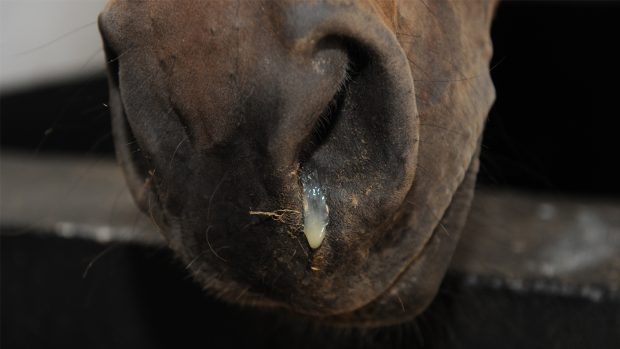For years it’s been thought that horses who swish their tail, put their ears back and open their mouth when being ridden are behaving negatively. However, recent research by vet Sue Dyson, a specialist in equine orthopaedics, has proved that these behaviours are often signs of musculoskeletal pain.
“These issues which have previously been labelled as training related, riding related, behavioural or ‘that’s the way the horse has always gone’ need to be challenged. A lack of recognition of pain-based behaviour results in coercive and punishment-based training, potential deterioration of the underlying problems and has deleterious consequences for equine welfare,” says Sue who explained the research at the recent online Pony Club Coaching Conference.
Three independent surveys in Sweden, Switzerland and the UK that looked at sports and leisure horses believed by their riders to be working comfortably showed that 50% of the horses were lame.
“These studies demonstrated how difficult riders find identifying lameness and why there’s a need to create a tool whereby the presence of musculoskeletal pain can be suspected,” explains Sue.
“The Ridden Horse Pain Ethogram (RHpE) was developed after evaluating 25 lame and 13 non-lame horses and applying an ethogram comprising of 117 behaviours, which had been devised from watching videos of approximately 150 lame and non-lame horses. From that we were able to determine 24 behaviours, the majority of which were at least 10 times more likely to be seen in lame versus non-lame horses.”
After applying the 24 behaviour RHpE to the 25 lame and 13 non-lame horses it was established that the most frequent score for non-lame horses was two and for lame horses was nine. It was determined that horses who display eight or more of these behaviours are likely to be suffering from musculoskeletal pain (although some lame horses score less than eight).
“The RHpE is a powerful tool. Even if owners are unable to recognise lameness by using the RHpE they’re able to identify the presence of a problem that may be subclinical and get help,” says Sue.
RHpE scores were then compared in lame horses before and after nerve blocks had been used to abolish lameness. There was a substantial reduction in the RHpE scores, all of which were much less than eight which proved a causal relationship between pain and behaviour.
“Some horses can live with problems and perform willingly and adequately. Unwillingness or displaying eight or more behaviours of the RHpE needs investigation. We have moral and ethical responsibilities to do this,” adds Sue.
Other factors such as rider skill, size and position in the saddle and tack fit could be influential in the demonstration of these behaviours. However, a study asking 40 riders on horses they ride regularly and a single professional rider to ride a prelim dressage test which included 10m circles to the left and right showed that while the professional rider may be able to improve the gait quality, they’re not able to conceal behavioural signs of discomfort.
A study of 102 dressage horses at World Cup level gave a median score of two on the RHpE and some of these behaviours were only displayed during biomechanically demanding movements like passage and piaffe. At the 2020 British Dressage National Convention the 14 horses studied scored between 0-10 with the average being three.
“The horses at the National Convention which scored between 7-10 on the RHpE showed comprised performance consistent with musculoskeletal pain – inadequate hind limb impulsion and engagement, limited ability to collect and poor canter,” says Sue.
Article continues below…
You might also be interested in:

Is your horse in pain? New videos explain the key signs
The aim of the video series is to improve welfare and performance in ridden horses

Subscribe to Horse & Hound magazine today – and enjoy unlimited website access all year round
Thirteen percent of 172 five-star event horses who were studied during the dressage warm up showed episodic forelimb or hindlimb lameness. These soundness issues generally manifested themselves in movements like shoulder in or half pass. Nineteen percent displayed abnormal canter traits.
“When comparing those event horses scoring less than seven on the RHpE with those scoring seven or more, the ones in the latter category had higher dressage scores, higher frequency of elimination or retirement on the cross-country and a lower finishing place,” reveals Sue.
“With appropriate investigation and management there’s the potential to improve all these horses’ performances and minimise the risk of performances deteriorating but education of all involved in the equine industry is needed.”
Would you like to read Horse & Hound’s independent journalism without any adverts? Join Horse & Hound Plus today and you can read all articles on HorseandHound.co.uk completely ad-free.




